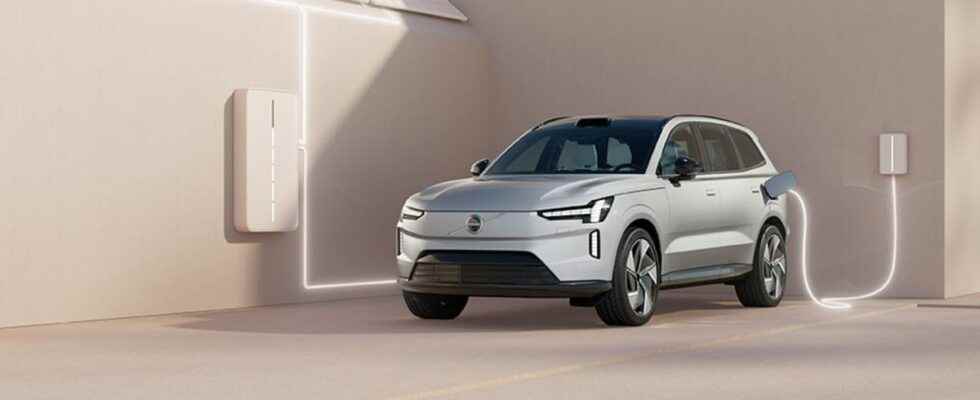Replacing the XC90 and future flagship of Volvo, a Swedish brand passed under the Chinese Geely, the EX90 is fully revealed after weeks of teasing. It started with sketches of the bodywork to finish with the ultra-simple interior featuring a large dashboard with two digital screens, including a 14.9-inch central one, as well as a steering wheel with haptic feedback controls. This uncluttered choice aims to offer a “simplified complexity” offering all the features the driver needs, without being intrusive, according to Thomas Stovicek, Volvo’s User Experience Manager.
It remained to discover the whole vehicle. It is clear that this EX90 is the technical cousin of Polestar 3, ex-sports subsidiary of Volvo Cars passed under the command of Geely. Thus, the two SUVs share the same SP2 platform and therefore have the same wheelbase of 2.985 m, identical to the XC90.
In terms of dimensions, the Swedish does not do half measures with 5.04 m in length, 1.96 m in width (2.11 m with mirrors) and 1.75 m in height. As for the empty weight, our EX90 displays 2.8 t, a little heavier than the Polestar 3 (between 2.584 and 2.670 t). The successor to the XC90 also comes with a towing capacity of 2.2 t, while the roof can support up to 100 kg of load.
A 111 kWh battery for 590 km
How far will the race for autonomy go? More and more “big” vehicles carry batteries whose capacity exceeds 100 kWh. Thus, the EX90 is no exception since its pack is 111 kWh (gross), including 107 kWh (400 V) of useful capacity. If the CATL supplier is the same as for the Polestar 3, Volvo has not communicated on the technical aspect of the cells and modules. For comparison, the Polestar 3 battery pack consists of 204 prismatic cells grouped into 17 modules, accompanied by a liquid cooling system and a heat pump.
The Volvo incorporates an 11 kW (AC) charger with bidirectional charging (Vehicle to Grid or V2G) making it possible to receive, but also to return electricity to the outside. Depending on the type of socket, it will take between 11 and 57 hours to recharge the battery.
Of course, the EX90 is compatible with fast charging (DC) up to 250 kW. Thus, from a 250 kW charging station, it only takes 30 minutes to go from 10 to 80% charge. On the other hand, on a 50 kW terminal, the charging time will be 96 min.
380 or 300 kW motor and speed limited to 180 km/h
Volvo offers two versions of different powers with all-wheel drive. The first, called Twin Motor Performance, has two electric motors with a total power of 380 kW (517 hp) for a torque of 910 Nm. The exercise from 0 to 100 km/h is completed in 4.9 s . The speed limit is deliberately restricted to 180 km/h in accordance with Volvo’s zero fatality policy. The announced range is 590 km (WLTP cycle).
The second engine, called Twin Motor, still has two electric motors, but whose power has been reduced to 300 kW (408 hp) for a maximum torque of 770 Nm. The 0 to 100 km / h is reached in 5.9 s . The announced range is 600 km (WLTP cycle).
Thus, the autonomy of the Polestar 3 is slightly higher (610 km), due in particular to a drag coefficient of 0.29 unlike the EX90 which retains the design of its predecessor. On the other hand, the EX90 is available in 7 places unlike the Polestar 3. Result, the roof line is higher, which necessarily has an impact on aerodynamics, and therefore autonomy.
In its 5-seater version, the boot volume reaches 655 l, and up to 1010 l up to the ceiling. In the 7-seater version and despite a third row, the volume is a minimum of 365 l and can go up to 1,915 l by folding down rows 2 and 3. A sub-compartment in the boot offers 65 l to which are added the 37 l from the front trunk, or frunky in English.
Level 3 autonomous driving
Technical cousin of the Polestar 3, the Volvo EX90 should carry the same safety and driving assistance systems. Thus, the EX90 has a visible LiDAR on the roof, above the windshield, capable of detecting any object within 250 m. In addition to the LiDAR, we should logically find no less than five radars, five external cameras and 12 ultrasonic sensors. The passenger compartment should also benefit from a radar capable of detecting movements over a range of less than one millimeter, making it possible to detect fatigue or driver distraction. This radar has the additional function of preventing a child or animal from being forgotten in the rear seats.
The piloting of the entire system is surely based on Nvidia Drive, which we do not know if it includes the SoC Orin (250 TOPS) or the next Atlan (1000 TOPS). On the other hand, infotainment via the central 14.5-inch touch screen will be managed by Qualcomm’s Snapdragon Cockpit platform. As for the operating system, it is based on Android Automotive, the famous OS co-developed with Google and compatible with remote updates.
Production of the Volvo EX90 is expected to begin first in South Carolina (USA) from 2023, then in China (Chengdu). However, no price has been disclosed. For comparison, the Polestar 3 Long Range Dual Motor will start at €89,900 in Europe, except for France where it is not planned to be marketed, unlike the Volvo EX90.

